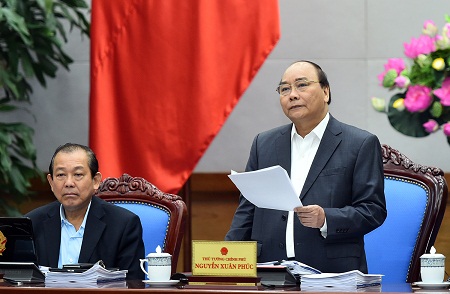VN’s 2017 GDP growth: From worry to breakthrough
VGP – The regular monthly cabinet meeting for March 2017 was memorable as the Government showed its strong determination to achieve the set targets after Prime Minister Nguyen Xuan Phuc voiced his “deep concern” about the country’s gross domestic product (GDP) growth rate in the first quarter of the year.
 |
Taking a look back at 2017, one of the most prominent results is the annual GDP growth of 6.7%. This is the first time in many years that Viet Nam has achieved the GDP growth target as planned, and this is also the highest growth rate the country has recorded over the past decade.
At the regular government meeting for March, cabinet members said that alongside the positive results obtained across a number of fields, the first-quarter
However, since the March regul
Concluding the regular cabinet meeting for April a month later, PM Nguyen Xuan Phuc continued to emphasize his determination to achieve the 6.7% growth rate set for 2017, without changing this target. As of May 22, he went on to summon a meeting with ministries and sectors in regards to the growth scenarios for 2017.
Some specific targets in key areas included the agricultural sector growing 3.05%, with farm produce exports reaching over US$33 billion; the industrial and construction sector growing 7.91%, with the industrial sector increasing 7% and the construction sector rising 10.5%; and the service sector growing 7.19%, with tourist arrivals increasing 30%.
The subsequent developments confirmed the effectiveness of synchronous and drastic solutions taken by the Government. By the third quarter, the GDP growth jumped sharply by 7.46%, much higher than in the first quarter (5.15%) and the second quarter (6.17%), resulting in the September GDP growth of 6.41% and making the year’s 6.7% target become feasible.
International organizations recognized Viet Nam’s GDP growth results. Most recently, on December 11, the World Bank raised Viet Nam’s GDP growth forecast for this year to 6.7%, equal to the Government’s expected target and higher than the forecast of 6.3% issued by the organization itself previously.
As of December 13, the Asian Development Bank (ADB) also raised Viet Nam’s GDP growth forecast to 6.7% for both 2017 and 2018, higher than its 6.3% and 6.5% forecasts announced previously. According to Bloomberg, Viet Nam will record the fastest GDP growth in Southeast Asia, at 6.6%, in 2018.
The issue of economic growth not only affects the macroeconomic indicators. 2017 is the second year of Viet Nam’s 2016-2020 five-year plan. The realization of the 6.7% target set for 2017 will contribute significantly and creating a momentum for the successful fulfilment of the five-year goals set by the Party Central Committee and the National Assembly.
By Vien Nhu

